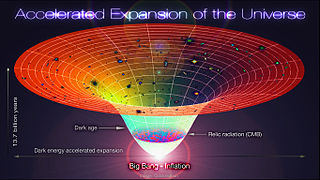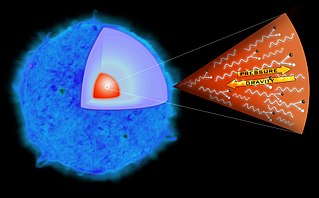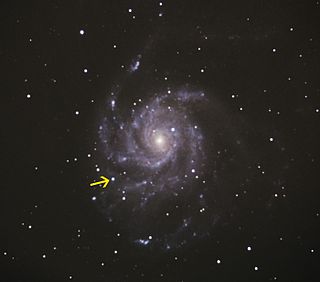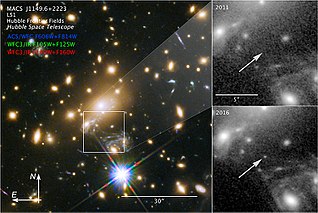Related Research Articles

A supernova is a powerful and luminous explosion of a star. A supernova occurs during the last evolutionary stages of a massive star or when a white dwarf is triggered into runaway nuclear fusion. The original object, called the progenitor, either collapses to a neutron star or black hole, or is completely destroyed to form a diffuse nebula. The peak optical luminosity of a supernova can be comparable to that of an entire galaxy before fading over several weeks or months.

Observations show that the expansion of the universe is accelerating, such that the velocity at which a distant galaxy recedes from the observer is continuously increasing with time. The accelerated expansion of the universe was discovered during 1998 by two independent projects, the Supernova Cosmology Project and the High-Z Supernova Search Team, which both used distant type Ia supernovae to measure the acceleration. The idea was that as type Ia supernovae have almost the same intrinsic brightness, and since objects that are further away appear dimmer, we can use the observed brightness of these supernovae to measure the distance to them. The distance can then be compared to the supernovae's cosmological redshift, which measures how much the universe has expanded since the supernova occurred; the Hubble law established that the further an object is from us, the faster it is receding. The unexpected result was that objects in the universe are moving away from one another at an accelerated rate. Cosmologists at the time expected that recession velocity would always be decelerating, due to the gravitational attraction of the matter in the universe. Three members of these two groups have subsequently been awarded Nobel Prizes for their discovery. Confirmatory evidence has been found in baryon acoustic oscillations, and in analyses of the clustering of galaxies.

Saul Perlmutter is a U.S. astrophysicist, a professor of physics at the University of California, Berkeley, where he holds the Franklin W. and Karen Weber Dabby Chair, and head of the International Supernova Cosmology Project at the Lawrence Berkeley National Laboratory. He is a member of both the American Academy of Arts & Sciences and the American Philosophical Society, and was elected a Fellow of the American Association for the Advancement of Science in 2003. He is also a member of the National Academy of Sciences. Perlmutter shared the 2006 Shaw Prize in Astronomy, the 2011 Nobel Prize in Physics, and the 2015 Breakthrough Prize in Fundamental Physics with Brian P. Schmidt and Adam Riess for providing evidence that the expansion of the universe is accelerating. Since 2021, he has been a member of the President’s Council of Advisors on Science and Technology (PCAST).

A Type Ia supernova is a type of supernova that occurs in binary systems in which one of the stars is a white dwarf. The other star can be anything from a giant star to an even smaller white dwarf.

NGC 1309 is a spiral galaxy located approximately 120 million light-years away, appearing in the constellation Eridanus. It is about 75,000 light-years across, and is about 3/4s the width of the Milky Way. Its shape is classified as SA(s)bc, meaning that it has moderately wound spiral arms and no ring. Bright blue areas of star formation can be seen in the spiral arms, while the yellowish central nucleus contains older-population stars. NGC 1309 is one of over 200 members of the Eridanus Group of galaxies.
The Supernova Cosmology Project is one of two research teams that determined the likelihood of an accelerating universe and therefore a positive cosmological constant, using data from the redshift of Type Ia supernovae. The project is headed by Saul Perlmutter at Lawrence Berkeley National Laboratory, with members from Australia, Chile, France, Portugal, Spain, Sweden, the United Kingdom, and the United States.

Adam Guy Riess is an American astrophysicist and Bloomberg Distinguished Professor at Johns Hopkins University and the Space Telescope Science Institute. He is known for his research in using supernovae as cosmological probes. Riess shared both the 2006 Shaw Prize in Astronomy and the 2011 Nobel Prize in Physics with Saul Perlmutter and Brian P. Schmidt for providing evidence that the expansion of the universe is accelerating.

A pair-instability supernova is a type of supernova predicted to occur when pair production, the production of free electrons and positrons in the collision between atomic nuclei and energetic gamma rays, temporarily reduces the internal radiation pressure supporting a supermassive star's core against gravitational collapse. This pressure drop leads to a partial collapse, which in turn causes greatly accelerated burning in a runaway thermonuclear explosion, resulting in the star being blown completely apart without leaving a stellar remnant behind.

In astronomy, a Hubble bubble would be "a departure of the local value of the Hubble constant from its globally averaged value," or, more technically, "a local monopole in the peculiar velocity field, perhaps caused by a local void in the mass density."

SN 2011fe, initially designated PTF 11kly, was a Type Ia supernova discovered by the Palomar Transient Factory (PTF) survey on 24 August 2011 during an automated review of images of the Messier 101 from the nights of 22 and 23 August 2011. It was located in Messier 101, the Pinwheel Galaxy, 21 million light years from Earth. It was observed by the PTF survey very near the beginning of its supernova event, when it was approximately 1 million times too dim to be visible to the naked eye. It is the youngest type Ia ever discovered. About 13 September 2011, it reached its maximum brightness of apparent magnitude +9.9 which equals an absolute magnitude of about -19, equal to 2.5 billion Suns. At +10 apparent magnitude around 5 September, SN 2011fe was visible in small telescopes. As of 30 September the supernova was at +11 apparent magnitude in the early evening sky after sunset above the northwest horizon. It had dropped to +13.7 as of 26 November 2011.
SN 2213-1745 was an extremely remote superluminous supernova (SLSN), which occurred in between November 2004 and June 2005. Its peak far-ultraviolet absolute magnitude reached −21.2, which was comparable to the total absolute magnitude of its host galaxy. The distance (redshift) to this supernova z=2.0458±0.0005 makes it one of the most remote supernova observed as of 2012. The luminosity of SN 2213-1745 evolved slowly over several years as it was still detectable in November 2006. Both the high luminosity and slow decay indicate that the supernova's progenitor was a star with an initial mass as high as 250 solar masses. The supernova explosion itself was likely a pair-instability supernova similar to the SN 2007bi event, with which it shares many similarities.

SN 1000+0216 was an extremely remote superluminous supernova (SLSN), which occurred in between June and November 2006 in the constellation Sextans. Its peak far-ultraviolet absolute magnitude reached −21.5, which exceeded the total absolute magnitude of its host galaxy. The distance (redshift) to this supernova z=3.8993 ± 0.0074 makes it the most distant supernova observed as of 2012. The luminosity of SN 1000+0216 evolved slowly over several years as it was still detectable in November 2008. Both the high luminosity and slow decay indicate that the supernova's progenitor was a very massive star. The supernova explosion itself was likely either a pair-instability supernova or a pulsational pair-instability supernova similar to the SN 2007bi event. It also had some similarities to the low redshift SN 2006gy supernova. Overall classification of SN 1000+0216 remains uncertain.

SN UDS10Wil is a type Ia supernova, and as of April 2013, the farthest known. It has a redshift of 1.914, which strongly implies that it exploded when the universe was about a third of its current size. It was discovered with the Hubble Space Telescope's Wide Field Camera 3. The nickname SN Wilson is after the American President Woodrow Wilson.

SN 2014J was a type-Ia supernova in Messier 82 discovered in mid-January 2014. It was the closest type-Ia supernova discovered for 42 years, and none have been closer as of 2018. The supernova was discovered by chance during an undergraduate teaching session at the University of London Observatory. It peaked on 31 January 2014, reaching an apparent magnitude of 10.5. SN 2014J was the subject of an intense observing campaign by professional astronomers and was bright enough to be seen by amateur astronomers.

A zombie star is a hypothetical result of a Type Iax supernova which leaves behind a remnant star, rather than completely dispersing the stellar mass. Type Iax supernovae are similar to Type Ia, but have a lower ejection velocity and lower luminosity. Type Iax supernovae may occur at a rate between 5 and 30 percent of the Ia supernova rate. Thirty supernovae have been identified in this category.

SN Refsdal is the first detected multiply-lensed supernova, visible within the field of the galaxy cluster MACS J1149+2223. It was given its nickname in honor of the Norwegian astrophysicist Sjur Refsdal, who, in 1964, first proposed using time-delayed images from a lensed supernova to study the expansion of the universe. The observations were made using the Hubble Space Telescope.
The KBC Void is an immense, comparatively empty region of space, named after astronomers Ryan Keenan, Amy Barger, and Lennox Cowie, who studied it in 2013. The existence of a local underdensity has been the subject of many pieces of literature and research articles.

MACS J1149 Lensed Star 1, also known as Icarus, is a blue supergiant star observed through a gravitational lens. It is the second most distant individual star to have been detected so far, at approximately 14 billion light-years from Earth. Light from the star was emitted 4.4 billion years after the Big Bang. According to co-discoverer Patrick Kelly, the star is at least a hundred times more distant than the next-farthest non-supernova star observed, SDSS J1229+1122, and is the first magnified individual star seen.
SN 2016aps is the brightest supernova explosion ever recorded. In addition to the sheer amount of energy released, an unusually large amount of the energy was released in the form of radiation, probably due to the interaction of the supernova ejecta and a previously lost gas shell.
References
- ↑ Cooke, Jeff; Sullivan, Mark; Gal-Yam, Avishay; Barton, Elizabeth J.; Carlberg, Raymond G.; Ryan-Weber, Emma V.; Horst, Chuck; Omori, Yuuki; Díaz, C. Gonzalo (2012). "Superluminous supernovae at redshifts of 2.05 and 3.90". Nature. 491 (7423): 228–31. arXiv: 1211.2003 . Bibcode:2012Natur.491..228C. doi:10.1038/nature11521. PMID 23123848. S2CID 4397580.
- 1 2 Hubble, Record-breaking supernova in the CANDELS Ultra Deep Survey: before, after, and difference, 4 April 2013
- ↑ Science Newsline, "The Farthest Supernova Yet for Measuring Cosmic History" Archived 2013-05-21 at the Wayback Machine , Lawrence Berkeley National Laboratory, 9 January 2013 (accessed 10 January 2013)
- ↑ Space.com, "Most Distant 'Standard Candle' Star Explosion Found", Mike Wall, 9 January 2013 (accessed 10 January 2013)
- ↑ Paul Preuss (2 April 2001). "Lucky Catch: Oldest, Most Distant Type Ia Supernova Confirmed By Supernova Analysis At NERSC". Lawrence Berkeley National Laboratory.
- ↑ Adam Riess (2 April 2001). "Farthest Supernova Ever - SN 1997ff (Overview)". Space Telescope Science Institute.
- ↑ Narciso Benitez; Adam G. Riess; Peter E. Nugent; Mark Dickinson; Ryan Chornock; Alexei V. Filippenko (3 July 2002). "The magnification of SN 1997ff, the farthest known Supernova". The Astrophysical Journal (published September 2002). 577 (1): L1–L4. arXiv: astro-ph/0207097 . Bibcode:2002ApJ...577L...1B. doi:10.1086/344048. S2CID 102327521.
- ↑ ESA, The Hubble eXtreme Deep Field, 25 September 2012

